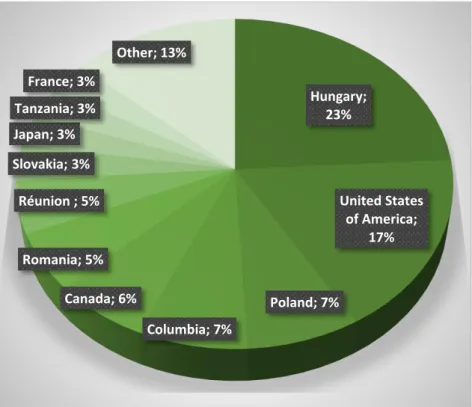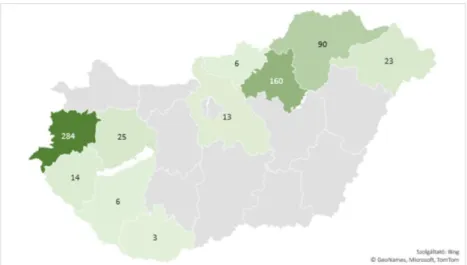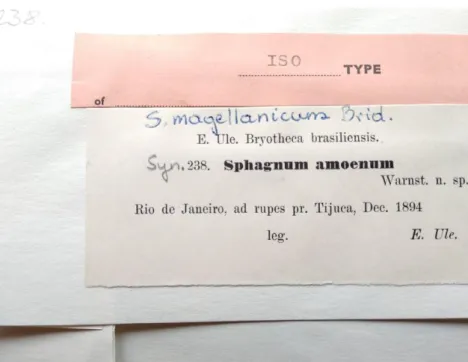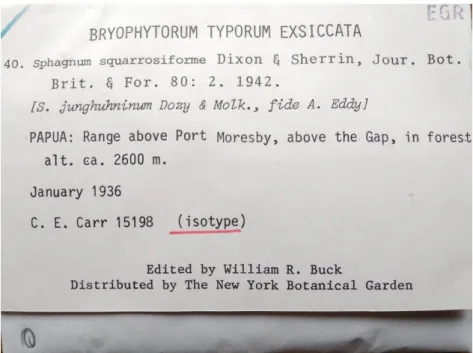BRYOPHYTE COLLECTION IN THE HERBARIUM OF ESZTERHÁZY KÁROLY UNIVERSITY (EGR): THE DIGITAL
DATABASE OF PEAT MOSS (SPHAGNUM) SPECIES Dávid Kapi1* & Andrea Sass-Gyarmati2
1Kozma Andor u. 6, H-3516 Miskolc, Hungary; 2Eszterházy Károly University, Institute of Biology, Department of Botany and Plant Physiology, H-3300 Eger,
Leányka u. 6, Hungary; *E-mail: kapidavid97@gmail.com
Abstract: The paper describes the Sphagnum peatmoss collection in the cryptogamic herbarium of the Eszterházy Károly University (EGR), Eger (Hungary), according to its condition in 2012. All specimens of the peatmosses were documented by digital photographs (2835 specimens), and all data from the labels were entered into MS Excel spreadsheet. 24 % of the specimens were collected in present-day Hungary, the majority of specimens comes mainly from the neighbouring countries, but more distant European lands are represented as well as overseas continents. Hungarian specimens were collected mostly in Vas, Heves, Borsod-Abaúj-Zemplén, Veszprém and Szabolcs-Szatmár-Bereg counties, areas with relatively more humid climate than the average of Hungary. Most of the herbarium sheets originated between 1950-1990’s. Apart from these periods the collection has hardly developed. The most prolific Hungarian collectors were:
Ádám Boros, László Vajda, Tamás Pócs, Márton Balogh and Ilona Gelencsér. In addition to this, many specimens were collected by foreigners as: Richard E.
Andrus, Antoine M. Cleef, Josef Duda, Adam Stebel, etc. The digital photographs and the database are property of the Department of Botany and Ecology of Eszterházy Károly University.
Keywords: biological collections, Sphagnum collection, herbarium digitization, natural history collections
INTRODUCTION
The herbarium of the Eszterházy Károly University (Index Herbariorum acronym: EGR, Index Herbariorum 2020) is the second largest herbarium in Hungary (Takács et al. 2014), consisting of two main parts. The cryptogam collection, which is one of the largest in Central Europe (200000 mosses and liverworts, and 8000 lichens) is widely known among bryologists. It
has gained an international reputation for the collections of Tamás Pócs and his colleagues, who studied and collected bryophytes all over the tropics. This collection comprises mainly lichens from Europe and Africa, but the main part are the bryophytes collected predominantly in the tropical regions of Africa, India, Indonesia, Vietnam, Papua New Guinea, Australia, Fiji, Cuba, Peru and Venezuela (Index Herbariorum 2020). The vascular collection is quite small in number, but not negligible (Sass-Gyarmati and Vojtkó 2010; Pénzesné Kónya et al. 2013). It is mainly valued for the age of its specimens, dating back to the early 19th century. It stores the collections of significant Hungarian botanists of that time, providing information about their trips and interests in certain regions or taxa. The vascular collection includes vouchers collected primarily in the territory of present-day Hungary and the neighboring countries (mainly in the Carpathian Basin), but there are specimens from the Alps, Silesia, the Balkan, and from the coastal regions of the Adriatic Sea as well. Only the vascular collection has been digitized up to now (E. Vojtkó et al. 2014).
Therefore, the digitization and analysis of the cryptogamic herbarium is still an actual challenge. We started this work in 2016 and our preliminary results were presented (Sass-Gyarmati et al.
2017). Our aim was to create a database of the Sphagnum species belonging to the cryptogamic collection of EGR, including all the main attributes of each herbarium specimen, accompanied by digital photos, which may be useful for floristic research. Currently, some other Hungarian herbaria are being processed similarly, e.g.
BP (Hungarian Natural History Museum) (Papp and Rajczy 1998), DE (Szarvas et al. 2010).
MATERIAL AND METHODS
The database comprises attributes of the material collected until 2012. Methods of digitization and database building process mostly followed Molnár V. et al. (2012) and Takács et al. (2014). The nomenclature of the species follows Michaelis (2019). Firstly, digital photographs were taken from each sheet, presenting the
correspond to individual records and columns represent attributes of the collected specimens. The following attributes were recorded:
(1) taxon name on the label, (2) collector, (3) reviewer, (4) locality, (5) altitude of locality, (6) year of gathering, (7) month of gathering, (8) day of gathering, and (9) filename of digital photo. One record of the database represents specimen(s) of the same taxon collected from the same locality at the same time on one sheet. If a herbarium sheet contains specimens either of different taxa or from a different locality or time, they are treated as separate records. Thus, the number of records (= rows in the database) is not equal to the number of herbarium sheets (= number of digital photos). When more than one settlement is given on the label, and the administrative affiliation of the locality is therefore ambiguous, the first settlement is provided as the location of gathering (e.g. in the case of “ In picetis uliginosis inter pag. Rábatótfalu et Apátistvánfalva;”, the administrative affiliation in the database is Rábatótfalu).
If collecting dates were given as intervals (very often in case of foreign collections) we record the earlier one. Data of Sphagnum database are summarized in an electronic appendix http://biologia.uni-eger.hu/en/biology/egr/database including:
catalogue number, taxon name, collector, settlement, date of gathering and file name of the documentary photograph). Further data can be required from the curator of the herbarium.
RESULTS AND DISCUSSION Geographical coverage
The database contains 2835 records altogether, and only 24% of the records (624 records) originates from Hungary, the rest comes from the neighboring and the overseas countries (USA: 17%, Poland: 8 %, Columbia: 8%, Romania: 6%, etc.) (Figure 1). We could not identify the country of origin in 368 further records (13%), though it is more than probable that these specimens were collected outside Hungary.
Figure 1. The number of collected specimens per countries.
Our analyses reveals that Sphagnum specimens collected in present-day Hungary (624 records) originated from only a smaller part of the country. Some counties are relatively overrepresented due to the special interests of the most prolific collectors of the herbarium and also probably due to the special researches conducted in peaty area and last but not least due to the climatic conditions.
The Sphagnum specimens of EGR under study were collected between 1850 and 2012. The intensity of collecting was very uneven, as the vast majority of specimens were obtained between 1950-1990 (Figure 3).
Hungary;
23%
United States of America;
17%
Poland; 7%
Columbia; 7%
Canada; 6%
Romania; 5%
Réunion ; 5%
Slovakia; 3%
Japan; 3%
Tanzania; 3%
France; 3%
Other; 13%
Figure 2. The number of collected specimens per counties in Hungary.
Figure 3. The number of collected specimens per decades.
Representations of the Sphagnum species and floristically significant records
More than 130 species, subspecies and varieties occur in the Sphagnum genus worldwide (Michaelis 2019). Some of the commonest species which occurs in the herbarium (EGR) are:
Sphagnum capillifolium (Ehrh.) Hedw., Sphagnum compactum DC.
ex. Lam. & DC., Sphagnum cuspidatum Ehrh. ex. Hoffm., Sphagnum fimbriatum Wilson and Sphagnum girgensohnii Russow. The two oldest Sphagnum specimens were collected by Weselsky in 1852, from Königgrätz and by J. E. Zetterstedt in June 23, 1860 from Sweden. Apart from the exsiccata specimens of Sphagnotheca Boreali-americana (Ed. R. E. Andrus and D.H. Vitt) we preserve the isotype of Sphagnum amoenum Warnst. (Bryotheca brasiliensis) and an isotype of Sphagnum squarrosiforme Dixon and Sherrin (Bryophytorum typorum exsiccata) in our collection (Figure.4, 5).
Figure 4. Isotype of Sphagnum amoenum Warnst. (foto: A. Sass-Gy.)
Figure 5. Isotype of Sphagnum squarrosiforme Dixon & Sherrin. (foto: A. Sass-Gy.)
CONCLUSIONS
In the Sphagnum collection, the specimens from Hungary are not separated from the foreign specimens, but can be found in a common storage cabinet. Only 24 % of the Sphagnum specimens comes from Hungary, and the other specimens comes as exchange or gift material to the herbarium through foreign researchers or collections made by Botany Department members (Madagascar 1994, 1996 and Réunion 1996). The greatest significance of the completed database is that the Sphagnum collection of the Herbarium is now electronically searchable, which facilitates the research work and more efficient management of the collection.
Based on the database, which is also available online, the species, country, collector name and year of the Sphagnum specimens are now searchable. For more detailed data contact of the herbarium curator is required, who can assign additional data and borrow the material if necessary. Domestic and foreign herbariums can also access the data, which can help with loaning between herbaria and provide information on the size and diversity of the herbarium
collection. Based on the results, we can get an idea of the spatial distribution of Sphagnum species both in Hungary and abroad. As Sphagnum species are the most important habitat for peat moss bogs, this provides feedback on their location or their actually existence. Subsequent research in the area may point to pollution factors if peat mosses are no longer found in the area.
Acknowledgement – The authors would like to express their gratitude to Professor Tamás Pócs and dr. Péter Szűcs for their useful comments. The second author’s research was supported by the grant EFOP-3.6.1-16-2016-00001 (“Complex improvement of research capacities and services at Eszterházy Károly University”).
REFERENCES
E.VOJTKÓ,A.,TAKÁCS,A.,MOLNÁR,V.A.&VOJTKÓ,A. (2014). Herbarium database of the vascular collection of Eszterházy Károly College (EGR). Kitaibelia 19: 339–348.
INDEX HERBARIORUM (2020).http://sweetgum.nybg.org/science/ih/ (accessed: June 10, 2020)
MICHAELIS,D. (2019). The Sphagnum species of the World. Schweizerbart Science Publishers. Bibliotheca Botanica, Vol. 162., 435 pp.
MOLNÁR,V.A.,TAKÁCS,A.,HORVÁTH,O.,E.VOJTKÓ,A.,KIRÁLY,G.,SONKOLY,J.,SULYOK,J.&
SRAMKÓ,G. (2012). Herbarium Database of Hungarian Orchids I. Methodology, dataset, historical aspects and taxa. Biologia 67: 79–86.
https://doi.org/10.2478/s11756-011-0144-9
PAPP,B.&RAJCZY,M. (1998). Moharitkaságok Magyarországon – előkészületek az új Vörös Lista összeállításához (Rare bryophytes in Hungary – preliminary efforts on compiling a new Red List). Kitaibelia 3(2): 355–356.
PÉNZESNÉ KÓNYA,E.,ORBÁN,S., PÓCS,T.& SASS-GYARMATI,A. (2013). Az Eszterházy Károly Főiskola megújult herbáriuma. Acta Academiae Agriensis Sectio Biologiae 40: 5–9.
SASS-GYARMATI,A.&VOJTKÓ,A. (2010). The herbarium of the Botanical Department in Károly Eszterházy College, Eger. Acta Biologica Plantarum Agriensis 1: 7–13.
SASS-GYARMATI,A.,PÉNZESNÉ KÓNYA,E.,KAPI,D.,STEFANCSIK,G.&KELECSÉNYI,F. (2017).
Bryophyte collection of Eszterházy Károly University (EGR): The digital database of peat moss (Sphagnum) species. Acta Biologica Plantarum Agriensis 5: 61. https://doi.org/10.21406/abpa.2017.5.1.61
SZARVAS,V.E.,TAKÁCS,A.&NAGY,M. (2010). A Debreceni Egyetem Herbáriumának mohagyűjteménye (The bryophyte collection of the University of Debrecen).
Kitaibelia 15(1–2): 65–72.
TAKÁCS,A.,NAGY,T.,FEKETE,R.,LOVAS-KISS,Á.,LJUBKA,T.,LÖKI,V.,LISZTES-SZABÓ,ZS.&
MOLNÁR,V.A. (2014). A Debreceni Egyetem Herbáriuma (DE) I.: A “Soó Rezső Herbárium” (The herbarium of Debrecen University (DE) I. The “Rezső Soó



